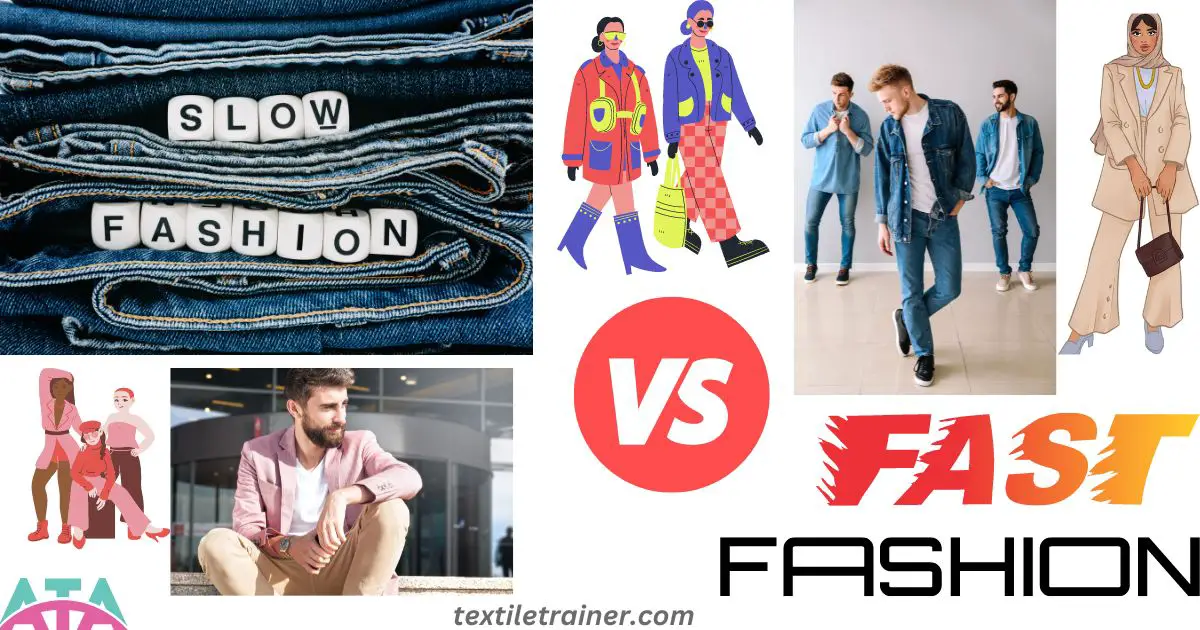What is Fashion?
Fashion encompasses a variety of styles, trends, and clothing choices that are prevalent at a particular point in history. Fashion is a form of self-expression, allowing individuals to express their personality, creativity, and social status through clothing, accessories, and hairstyles. Fashion is a dynamic industry that continuously evolves and is influenced by several factors, such as cultural, social, economic, and technological changes. This article is about differences between slow fashion and fast fashion
It is through the work of designers, influencers, celebrities, and even street style that fashion trends emerge. Colour palettes, silhouettes, fabric choices, and overall design aesthetics can change from season to season. Among the segments of the fashion industry are haute couture, ready-to-wear, streetwear, sportswear, accessories, and more. Fashion houses produce haute couture, which is high-end, custom-made clothing. Fashion products available in standard sizes in ready-to-wear are also referred to as ready-to-wear. Fashionable and comfortable, streetwear is often influenced by youth culture and characterized by individuality and comfort. Active lifestyles and athletic activities are catered to through sportswear. Accessories, such as shoes, handbags, jewellery, and eyeglasses, are also part of fashion trends. The fashion industry also includes beauty and grooming trends, including makeup, hairstyles, and skincare. During the last few years, sustainability and ethical practices have gained significant attention in the fashion industry. Increasingly, designers and brands focus on reducing waste, using organic materials, and ensuring fair labour practices in their production processes. The concept of fashion extends beyond clothing and personal style. As well as serving as an expression of artistic intent, it defines cultural identities and reflects societal values. Fashion shows, exhibitions, magazines, and online platforms serve as platforms to showcase new designs, celebrate creativity, and inspire individuals in their personal style choices. Fashion is a diverse and ever-evolving industry that reflects and shapes our tastes, cultures, and identities.
We will learn about 10 key differences between slow fashion and fast fashion in this article. In order to fully understand the difference between fast fashion and slow fashion, let us first examine what the two terms mean before we go further.
Slow Fashion:
Slow fashion is a fashion approach that emphasizes quality, sustainability, and ethical practices. This industry contrasts with the fast fashion industry, which is known for rapid production, low-quality garments, and exploitative labour practices. The concept of slow fashion encourages consumers to consume clothing more mindfully and consciously. Rather than continually purchasing cheap, trendy garments that fall out of style or lose their durability, it encourages consumers to buy fewer items of higher quality that will last.
Fast Fashion
Fashion that is fast or fast fashion is characterized by the production and consumption of cheap, trendy clothes in a rapid manner. It is characterized by rapidly changing fashion trends, low prices, and a high inventory turnover. In addition to its affordability and quick access to the latest styles, fast fashion has been scrutinized for its negative impact on labour practices, the environment, and sustainability. Therefore, a growing movement has been favoring alternative approaches, such as slow fashion, which emphasizes ethical production, sustainability, and conscious consumption.
Differences Between Slow Fashion and Fast Fashion:
| SL No. | Topic | Slow Fashion | Fast Fashion |
| 01 | Production time | Slow fashion brands prioritize quality over quantity and typically take longer to produce their clothing lines | While fast fashion brands prioritize speed and produce clothing quickly and cheaply. |
| 02 | Quality | Slow fashion brands focus on using high-quality materials that are durable and meant to last long. | While fast fashion brands often use low-quality materials that are not built to withstand regular wear and tear. |
| 03 | Price | Slow fashion clothing tends to be more expensive due to the higher quality materials and fair labor practices used in production | While fast fashion clothing is often cheaper due to the lower quality materials and exploitative labor practices. |
| 04 | Ethical labor practices | Slow fashion brands prioritize fair labor practices, including paying workers a proper wage | While fast fashion brands have been criticized for their use of sweatshop labor and poor working conditions. |
| 05 | Environmental impact | Slow fashion brands use sustainable production methods and prioritize minimizing their environmental impact | While fast fashion is associated with massive amounts of textile waste and pollution generated during production. |
| 06 | Trend focus | Slow fashion focuses on timeless designs and classic styles that are meant to be worn for years | While fast fashion prioritizes chasing trends and producing large quantities of clothing to meet consumer demand. |
| 07 | Consumer behavior | Slow fashion encourages consumers to invest in high-quality, timeless pieces that they will wear for years | While fast fashion encourages consumers to constantly purchase new clothing. |
| 08 | Transparency | Slow fashion brands prioritize transparency and often share information about their production methods and labor practices | While fast fashion brands are often criticized for their lack of transparency. |
| 09 | Community involvement | Slow fashion brands often prioritize local production and community involvement | While fast fashion brands are often associated with large, global corporations. |
| 10 | Mindful consumption | Slow fashion promotes a more mindful and conscious approach to fashion consumption, encouraging consumers to invest in high-quality clothing that will last, rather than constantly purchasing cheap, disposable clothing. | It doesn’t. |
Finally we can say, slow fashion seeks to reduce the negative impact of the fashion industry on the environment and improve working conditions for garment workers, while promoting a more conscious and mindful approach to clothing consumption. Where Fast fashion has become increasingly popular in recent years due to its low prices and the constant influx of new styles and trends. However, it is now being criticized for its negative impact on the environment and the people involved in the production process.







Thanks a lot for the blog. Much obliged.
thanks for comments